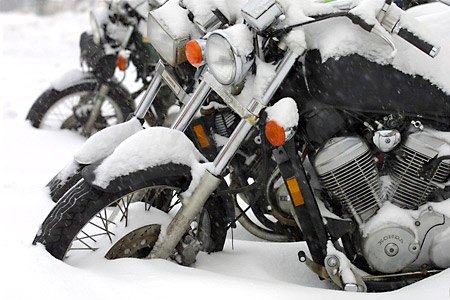Two-Wheeled Winter Blues
As the sun starts setting earlier in the evening and the leaves on the trees begin to change, those fair-weather bikers from the North Country may be starting to think about tucking their beloved beasts away for that long winter nap.
There are several things you can do to ensure your bike will be just as ready to go as you will be at the first genuine signs of spring.
Taking the time to thoroughly wash and dry your chrome horse is an effective way to protect all of its surfaces. The sooner you remove dirt, road grime and prematurely expired insects, the better. Letting them sit for the winter will likely contribute to the degradation of chrome and paint surfaces, and nobody wants that. Thoroughly washing your bike will also assist in pinpointing any small issues before they turn into big ones.
A routine comprehensive circle check should be done to ensure no mechanical issues have arisen since your last ride. This can include making sure spokes are tight, forks and shocks are leak-free and tire pressure is at an even and appropriate level. Tire pressure should be monitored routinely throughout the winter to ensure proper inflation, especially if you don’t keep your bike elevated off the ground on a stand. The rationale behind this is obvious; flat tires can lead to flat spots, cracked sidewalls and a host of other pains in your derriere. Inspecting your tires regularly and keeping them properly inflated is always a good idea. But it's particularly important when the bike will be standing for a long period in one position.
Throttle, clutch and brake cables should be inspected and lubricated to prevent premature wear or seizing during the cold winter months too. Pros recommend changing and topping up all essential fluids because dirt and other contaminants can accumulate inside your engine, transmission and crankcase while you ride. During storage, such foreign deposits as well as unburned fuel, exhaust gases or water vapor can do nasty things to the unseen and intricate workings of your machine.
The gas tank should be filled whenever your vehicle is parked for extended periods, but especially in cold weather. This is because the cold empty space in the tank will create a vacuum that invites unwanted air from the outside. This encourages corrosion, which I don’t think I have to tell you, is bad.
Gasoline can break down over time, setting the stage for gummed up fuel lines or injectors (or even carburetors depending on your bike) so adding a simple fuel stabilizer will greatly reduce the potential of this occurring. It is relatively inexpensive and can be found at most hardware stores or automotive shops. It is a small detail but one that can save huge problems down the road. After changing and adding these new fluids, the engine should be run for a few minutes to work the newly mixed concoction throughout its intended route.
Paying attention to your battery over the winter months can mean the difference between hearing the soulful sound of your engine, or nothing at all come spring. Ideally, it should be removed from the bike and be charged every few weeks. If you choose to leave the battery in place, attaching a trickle charger is never a bad idea. When a battery is not used regularly, it gradually loses its charge, especially with the strain of electronics such as security systems. For more detailed information on this process, check out our simple installation of the Ctek Multi US 3300.
Plastic tarps are often used to protect boats, cars and motorcycles from the elements when the vehicles are not in use. Not only are they unsightly, but some covers trap moisture, increasing the likelihood of corrosion. Breathable, waterproof covers range in price depending on quality and size, but are well worth the investment.
Even if you have a cover, your bike should ideally be kept indoors in a dry, safe place. Finding the right spot may just be the most important piece of the puzzle. Many variables such as freezing and thawing or exposure to dirt and chemicals in the air can have detrimental effects on your prized possession. And remember that furry critters may be searching for a place to nest during the cold months.
I am well aware that going through the winter storage process isn’t nearly as much fun as getting that one last chilly ride under your belt. It may seem expensive, inconvenient and even excessive. However, the effort will pay off when it comes time to wake the beast from its seasonal slumber when spring has finally sprung.
More by Dustin Woods




























Comments
Join the conversation